(完整版)小学英语形容词比较级顺口溜
英语语法顺口溜:形容词和副词的比较级口诀及用法
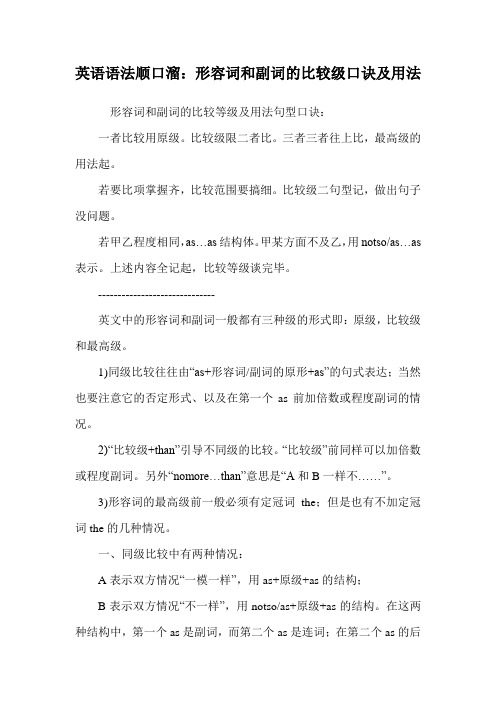
英语语法顺口溜:形容词和副词的比较级口诀及用法形容词和副词的比较等级及用法句型口诀:一者比较用原级。
比较级限二者比。
三者三者往上比,最高级的用法起。
若要比项掌握齐,比较范围要搞细。
比较级二句型记,做出句子没问题。
若甲乙程度相同,as…as结构体。
甲某方面不及乙,用notso/as…as 表示。
上述内容全记起,比较等级谈完毕。
------------------------------英文中的形容词和副词一般都有三种级的形式即:原级,比较级和最高级。
1)同级比较往往由“as+形容词/副词的原形+as”的句式表达;当然也要注意它的否定形式、以及在第一个as前加倍数或程度副词的情况。
2)“比较级+than”引导不同级的比较。
“比较级”前同样可以加倍数或程度副词。
另外“nomore…than”意思是“A和B一样不……”。
3)形容词的最高级前一般必须有定冠词the;但是也有不加定冠词the的几种情况。
一、同级比较中有两种情况:A表示双方情况“一模一样”,用as+原级+as的结构;B表示双方情况“不一样”,用notso/as+原级+as的结构。
在这两种结构中,第一个as是副词,而第二个as是连词;在第二个as的后面接名词、句子或代词的主格。
例如:Myparcelisasheavyasyours.我的包裹与他的一样沉。
Hisbedroomisnotasneatashissister‘s.他的卧室没有他姐姐的整洁。
Itisnotsohotasyesterday.今天不象昨天那么热。
*在as…as的结构中,我们还常见这样两种句型:asmuch+不可数名词+as和asmany+复数可数名词+as。
例如:HehaslearnedasmanyEnglishwordsashisbrother.他已学了和他哥哥一样多的英文单字。
二、形容词比较级的用法:形容词的比较级用于两个人或事物的比较,其结构形式如下:主语+谓语+形容词比较级+than+对比成分。
副词形容词比较级最高级小口诀
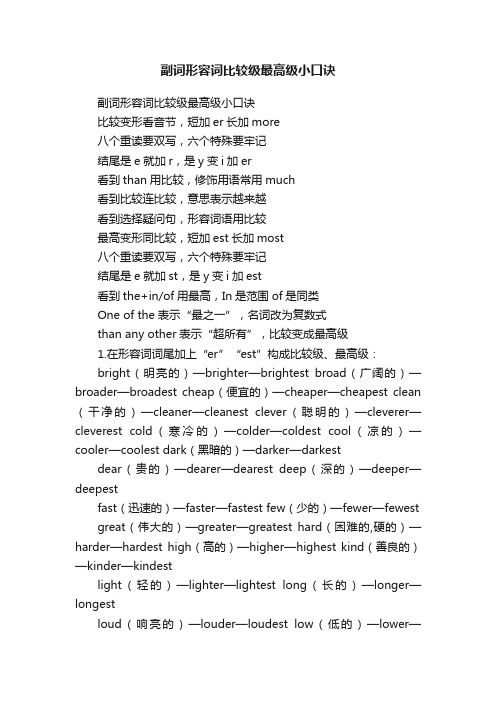
副词形容词比较级最高级小口诀副词形容词比较级最高级小口诀比较变形看音节,短加er长加more八个重读要双写,六个特殊要牢记结尾是e就加r,是y变i加er看到than用比较,修饰用语常用much看到比较连比较,意思表示越来越看到选择疑问句,形容词语用比较最高变形同比较,短加est长加most八个重读要双写,六个特殊要牢记结尾是e就加st,是y变i加est看到the+in/of用最高,In是范围of是同类One of the表示“最之一”,名词改为复数式than any other表示“超所有”,比较变成最高级1.在形容词词尾加上“er”“est”构成比较级、最高级:bright(明亮的)—brighter—brightest broad(广阔的)—broader—broadest cheap(便宜的)—cheaper—cheapest clean (干净的)—cleaner—cleanest clever(聪明的)—cleverer—cleverest cold(寒冷的)—colder—coldest cool(凉的)—cooler—coolest dark(黑暗的)—darker—darkestdear(贵的)—dearer—dearest deep(深的)—deeper—deepestfast(迅速的)—faster—fastest few(少的)—fewer—fewest great(伟大的)—greater—greatest hard(困难的,硬的)—harder—hardest high(高的)—higher—highest kind(善良的)—kinder—kindestlight(轻的)—lighter—lightest long(长的)—longer—longestloud(响亮的)—louder—loudest low(低的)—lower—lowestnear(近的)—nearer—nearest new(新的)—newer—newestpoor(穷的)—poorer—poorest quick(快的)—quicker—quickestquiet(安静的)—quieter—quietest rich(富裕的)—richer—richestshort(短的)—shorter—shortest slow(慢的)—slower—slowestsmall(小的)—smaller—smallest smart(聪明的)—smarter—smartest soft(柔软的)—softer—softest strong(强壮的)—stronger—strongest sweet(甜的)—sweeter—sweetest tall(高的)-taller-tallestthick(厚的)—thicker—thickest warm(温暖的)—warmer—warmest weak(弱的)—weaker—weakest young(年轻的)—younger—youngest 2.双写最后一个字母,再加上“er”“est”构成比较级、最高级:big(大的)—bigger—biggest fat(胖的)—fatter—fattesthot(热的)—hotter—hottest red(红的)—redder—reddestsad(伤心的)—sadder—saddest thin(瘦的)—thinner—thinnestwet(湿的)—wetter—wettest mad(疯的)—madder—maddest3.以不发音的字母e结尾的形容词,加上“r”、“st”构成比较级、最高级:able(能干的)—abler—ablest brave(勇敢的)—braver—bravestclose(接近的)—closer—closest fine(好的,完美的)—finer—finestlarge(巨大的)—larger—largest late(迟的)—later—latestnice(好的)—nicer—nicest ripe(成熟的)—riper—ripestrude(粗鲁的)—ruder—rudest safe(安全的)—safer—safeststrange(奇怪的)—stranger—strangest wide(宽广的)—wider—widestwise(睿智的,聪明的)—wiser—wisest white(白的)—whiter—whitest4.以字母y结尾的形容词,把y改为i,再加上“er”、“est”构成比较级、最高级:busy(忙碌的)—busier—busiest dirty(脏的)—dirtier—dirtiestdry(干燥的)—drier—driest early(早的)—earlier—earliesteasy(容易的)—easier—easiest friendly(友好的)—friendlier—friendliestfunny(好玩的)—funnier—funniest happy(开心的)—happier—happiest healthy(健康的)—healthier—healthiest heavy(重的)—heavier—heaviest hungry(饿的)—hungrier—hungriest lazy(懒惰的)—lazier—laziestlucky(幸运的)—luckier—luckiest naughty(调皮的)—naughtier—naughtiest noisy(嘈杂的)—noisier—noisiest pretty (美丽的)—prettier—prettiestsilly(傻的)—sillier—silliest spicy(辣的)—spicier—spiciest thirsty(渴的)—thirstier—thirstiest ugly(丑的)—uglier—ugliest5.双音节、多音节形容词,在单词前面加上“more”“most”构成比较级、最高级:afraid(害怕的)—more afraid—most afraid beautiful(美丽的)—more beautiful—most beautifulcareful(仔细的)—more careful—most carefulcheerful(开心的)—more cheerful—most cheerfulcrowded(拥挤的)—more crowded—most crowdeddangerous(危险的)—more dangerous—most dangerous delicious(美味的)—more delicious—most deliciousdifficult(困难的)—more difficult—most difficultexciting(令人兴奋的)—more exciting—most excitingexpensive(昂贵的)—more expensive—most expensivefamous(著名的)—more famous—most famousfrightened(受惊的)—more frightened—most frightened frightening(令人害怕的)—more frightening—most frighteninghard-working(勤奋的)—more hard-working—most hard-workinghelpful(有帮助的)—more helpful—most helpfulhonest(诚实的)—more honest—most honestimportant(重要的)—more important—most importantinteresting(有趣的)—more interesting—most interesting polite(有礼貌的)—more polite—most politeterrible(可怕的)—more terrible—most terribletired(累的)—more tired—most tired6.不规则变化的形容词:good(好的)/ well(好的)—better—bestbad(坏的)/ badly(坏的)/ ill(病的)—worse—worstmany(多的)/ much(多的)—more—mostlittle(少的)—less—leastold(老的)—older/ elder—oldest/ eldestfar(远的)—farther/ further—farthest furthest。
英语语法:形容词和副词的比较级口诀及用法
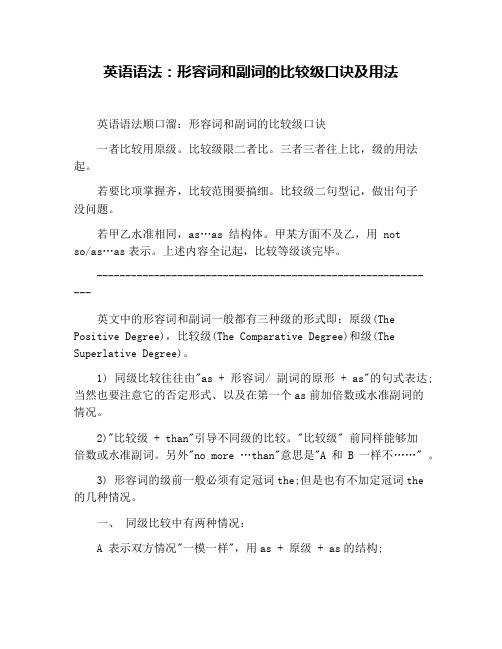
英语语法:形容词和副词的比较级口诀及用法英语语法顺口溜:形容词和副词的比较级口诀一者比较用原级。
比较级限二者比。
三者三者往上比,级的用法起。
若要比项掌握齐,比较范围要搞细。
比较级二句型记,做出句子没问题。
若甲乙水准相同,as…as 结构体。
甲某方面不及乙,用 notso/as…as表示。
上述内容全记起,比较等级谈完毕。
------------------------------------------------------------英文中的形容词和副词一般都有三种级的形式即:原级(The Positive Degree),比较级(The Comparative Degree)和级(The Superlative Degree)。
1) 同级比较往往由"as + 形容词/ 副词的原形 + as"的句式表达;当然也要注意它的否定形式、以及在第一个as前加倍数或水准副词的情况。
2)"比较级 + than"引导不同级的比较。
"比较级" 前同样能够加倍数或水准副词。
另外"no more …than"意思是"A和B一样不……" 。
3) 形容词的级前一般必须有定冠词the;但是也有不加定冠词the的几种情况。
一、同级比较中有两种情况:A 表示双方情况"一模一样",用as + 原级 + as的结构;B 表示双方情况"不(那么)一样",用not so / as + 原级 + as的结构。
在这两种结构中,第一个as是副词,而第二个as是连词;在第二个as的后面接名词、句子或代词的主格(一般不要接代词的宾格)。
例如:My parcel is as heavy as yours . 我的包裹与他的一样沉。
His bedroom is not as neat as his sister's. 他的卧室没有他姐姐的整洁。
形容词及比较级用法顺口溜
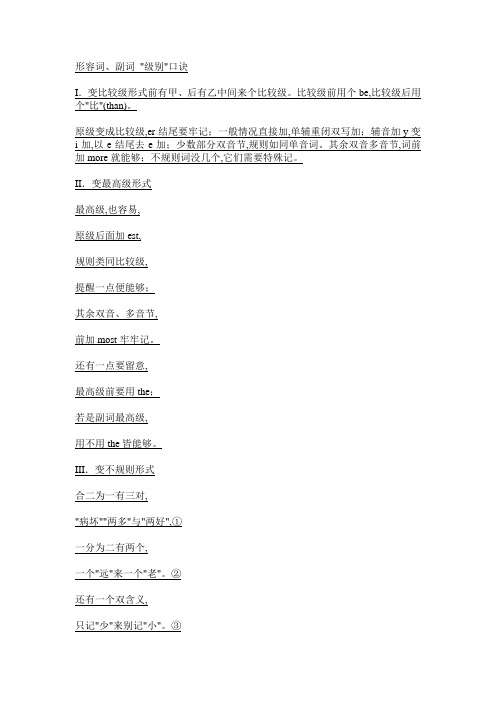
形容词、副词"级别"口诀I.变比较级形式前有甲、后有乙中间来个比较级。
比较级前用个be,比较级后用个"比"(than)。
原级变成比较级,er结尾要牢记;一般情况直接加,单辅重闭双写加;辅音加y变i加,以e结尾去e加;少数部分双音节,规则如同单音词。
其余双音多音节,词前加more就能够;不规则词没几个,它们需要特殊记。
II.变最高级形式最高级,也容易,原级后面加est,规则类同比较级,提醒一点便能够;其余双音、多音节,前加most牢牢记。
还有一点要留意,最高级前要用the;若是副词最高级,用不用the皆能够。
III.变不规则形式合二为一有三对,"病坏""两多"与"两好",①一分为二有两个,一个"远"来一个"老"。
②还有一个双含义,只记"少"来别记"小"。
③注:①ill/ bad→worse→worst; many/ much→more→most; good/well→better→best②far→farther/further→farthest/furthest; old/older/elder→oldest/ eldest③little→less→least形容词比较等级形容词最高级前不加the的情况在句中使用形容词最高级时,一般要加定冠词the.但以下几种情况,最高级之前不加定冠词。
一、如果形容词最高级用来增强语气,表示"非常、极其"的意思时,前面一般不用定冠词,但有时能够加不定冠词。
例如:He is a most careful student in our class. 他是我们班上一个非常细心的学生。
She is in closest touch with us .她和我们保持非常密切的联系。
副词形容词比较级最高级小口诀

副词形容词比较级最高级小口诀比较变形看音节,短加er长加more八个重读要双写,六个特殊要牢记结尾是e就加r,是y变i加er看到than用比较,修饰用语常用much看到比较连比较,意思表示越来越看到选择疑问句,形容词语用比较最高变形同比较,短加est长加most八个重读要双写,六个特殊要牢记结尾是e就加st,是y变i加est看到the+in/of用最高,In是范围of是同类One of the表示“最之一”,名词改为复数式than any other表示“超所有”,比较变成最高级1.在形容词词尾加上“er”“est”构成比较级、最高级:bright(明亮的)—brighter—brightest broad(广阔的)—broader—broadest cheap(便宜的)—cheaper—cheapest clean(干净的)—cleaner—cleanest clever(聪明的)—cleverer—cleverest cold(寒冷的)—colder—coldest cool(凉的)—cooler—coolest dark(黑暗的)—darker—darkestdear(贵的)—dearer—dearest deep(深的)—deeper—deepestfast(迅速的)—faster—fastest few(少的)—fewer—fewestgreat(伟大的)—greater—greatest hard(困难的,硬的)—harder—hardest high(高的)—higher—highest kind(善良的)—kinder—kindestlight(轻的)—lighter—lightest long(长的)—longer—longestloud(响亮的)—louder—loudest low(低的)—lower—lowestnear(近的)—nearer—nearest new(新的)—newer—newestpoor(穷的)—poorer—poorest quick(快的)—quicker—quickestquiet(安静的)—quieter—quietest rich(富裕的)—richer—richestshort(短的)—shorter—shortest slow(慢的)—slower—slowestsmall(小的)—smaller—smallest smart(聪明的)—smarter—smartest soft(柔软的)—softer—softest strong(强壮的)—stronger—strongest sweet(甜的)—sweeter—sweetest tall(高的)-taller-tallestthick(厚的)—thicker—thickest warm(温暖的)—warmer—warmest weak(弱的)—weaker—weakest young(年轻的)—younger—youngest 2.双写最后一个字母,再加上“er”“est”构成比较级、最高级:big(大的)—bigger—biggest fat(胖的)—fatter—fattesthot(热的)—hotter—hottest red(红的)—redder—reddestsad(伤心的)—sadder—saddest thin(瘦的)—thinner—thinnestwet(湿的)—wetter—wettest mad(疯的)—madder—maddest3.以不发音的字母e结尾的形容词,加上“r”、“st”构成比较级、最高级:able(能干的)—abler—ablest brave(勇敢的)—braver—bravestclose(接近的)—closer—closest fine(好的,完美的)—finer—finestlarge(巨大的)—larger—largest late(迟的)—later—latestnice(好的)—nicer—nicest ripe(成熟的)—riper—ripestrude(粗鲁的)—ruder—rudest safe(安全的)—safer—safeststrange(奇怪的)—stranger—strangest wide(宽广的)—wider—widestwise(睿智的,聪明的)—wiser—wisest white(白的)—whiter—whitest4.以字母y结尾的形容词,把y改为i,再加上“er”、“est”构成比较级、最高级:busy(忙碌的)—busier—busiest dirty(脏的)—dirtier—dirtiestdry(干燥的)—drier—driest early(早的)—earlier—earliesteasy(容易的)—easier—easiest friendly(友好的)—friendlier—friendliestfunny(好玩的)—funnier—funniest happy(开心的)—happier—happiest healthy(健康的)—healthier—healthiest heavy(重的)—heavier—heaviest hungry(饿的)—hungrier—hungriest lazy(懒惰的)—lazier—laziestlucky(幸运的)—luckier—luckiest naughty(调皮的)—naughtier—naughtiest noisy(嘈杂的)—noisier—noisiest pretty(美丽的)—prettier—prettiestsilly(傻的)—sillier—silliest spicy(辣的)—spicier—spiciestthirsty(渴的)—thirstier—thirstiest ugly(丑的)—uglier—ugliest5.双音节、多音节形容词,在单词前面加上“more”“most”构成比较级、最高级:afraid(害怕的)—more afraid—most afraidbeautiful(美丽的)—more beautiful—most beautifulcareful(仔细的)—more careful—most carefulcheerful(开心的)—more cheerful—most cheerfulcrowded(拥挤的)—more crowded—most crowdeddangerous(危险的)—more dangerous—most dangerousdelicious(美味的)—more delicious—most deliciousdifficult(困难的)—more difficult—most difficultexciting(令人兴奋的)—more exciting—most excitingexpensive(昂贵的)—more expensive—most expensivefamous(著名的)—more famous—most famousfrightened(受惊的)—more frightened—most frightenedfrightening(令人害怕的)—more frightening—most frighteninghard-working(勤奋的)—more hard-working—most hard-workinghelpful(有帮助的)—more helpful—most helpfulhonest(诚实的)—more honest—most honestimportant(重要的)—more important—most importantinteresting(有趣的)—more interesting—most interestingpolite(有礼貌的)—more polite—most politeterrible(可怕的)—more terrible—most terribletired(累的)—more tired—most tired6.不规则变化的形容词:good(好的)/ well(好的)—better—bestbad(坏的)/ badly(坏的)/ ill(病的)—worse—worstmany(多的)/ much(多的)—more—mostlittle(少的)—less—leastold(老的)—older/ elder—oldest/ eldestfar(远的)—farther/ further—farthest furthest。
英语语法顺口溜:形容词和副词的比较级口诀及用法

英语语法顺口溜:形容词和副词的比较级口诀及用法英语语法顺口溜:形容词和副词的比较级口诀一者比较用原级。
比较级限二者比。
三者三者往上比,最高级的用法起。
若要比项掌握齐,比较范围要搞细。
比较级二句型记,做出句子没问题。
若甲乙程度相同,as…as 结构体。
甲某方面不及乙,用not so/as…as表示。
上述内容全记起,比较等级谈完毕。
英文中的形容词和副词一般都有三种级的形式即:原级,比较级和最高级。
1)同级比较往往由“as + 形容词/ 副词的原形+ as”的句式表达;当然也要注意它的否定形式、以及在第一个as 前加倍数或程度副词的情况。
2)“比较级+ than”引导不同级的比较。
“比较级” 前同样可以加倍数或程度副词。
另外“no more …than”意思是“A 和B一样不……” .3)形容词的最高级前一般必须有定冠词the;但是也有不加定冠词the的几种情况。
A 表示双方情况“一模一样”,用as+原级+as的结构;B 表示双方情况“不一样”,用not so / as + 原级+ as的结构。
在这两种结构中,第一个as是副词,而第二个as是连词;在第二个as的后面接名词、句子或代词的主格。
例如:My parcel is as heavy as yours . 我的包裹与他的一样沉。
His bedroom is not as neat as his sister’s. 他的卧室没有他姐姐的整洁。
It is not so hot as yesterday. 今天不象昨天那么热。
* 在as … as 的结构中,我们还常见这样两种句型:as much+不可数名词+ as和as many+复数可数名词+ as。
例如:He has learned as many English words as his brother.他已学了和他哥哥一样多的英文单字。
形容词的比较级用于两个人或事物的比较,其结构形式如下:主语+谓语+形容词比较级+than+ 对比成分。
形容词比较级,一般过去时语法记忆口诀
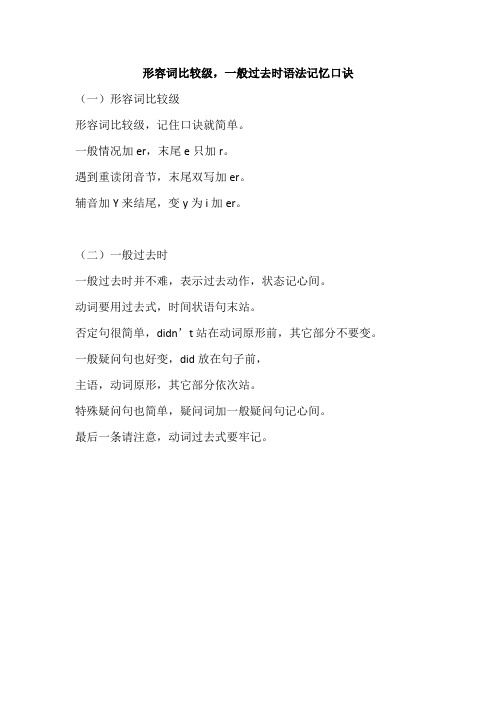
形容词比较级,一般过去时语法记忆口诀(一)形容词比较级
形容词比较级,记住口诀就简单。
一般情况加er,末尾e只加r。
遇到重读闭音节,末尾双写加er。
辅音加Y来结尾,变y为i加er。
(二)一般过去时
一般过去时并不难,表示过去动作,状态记心间。
动词要用过去式,时间状语句末站。
否定句很简单,didn’t 站在动词原形前,其它部分不要变。
一般疑问句也好变,did放在句子前,
主语,动词原形,其它部分依次站。
特殊疑问句也简单,疑问词加一般疑问句记心间。
最后一条请注意,动词过去式要牢记。
英语语法顺口溜:形容词和副词的比较级口诀及用法
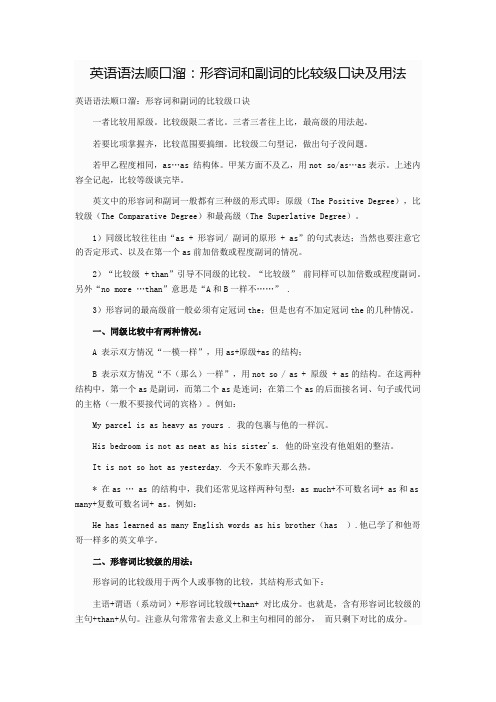
英语语法顺口溜:形容词和副词的比较级口诀及用法英语语法顺口溜:形容词和副词的比较级口诀一者比较用原级。
比较级限二者比。
三者三者往上比,最高级的用法起。
若要比项掌握齐,比较范围要搞细。
比较级二句型记,做出句子没问题。
若甲乙程度相同,as…as 结构体。
甲某方面不及乙,用not so/as…as表示。
上述内容全记起,比较等级谈完毕。
英文中的形容词和副词一般都有三种级的形式即:原级(The Positive Degree),比较级(The Comparative Degree)和最高级(The Superlative Degree)。
1)同级比较往往由“as + 形容词/ 副词的原形 + as”的句式表达;当然也要注意它的否定形式、以及在第一个as前加倍数或程度副词的情况。
2)“比较级 + than”引导不同级的比较。
“比较级”前同样可以加倍数或程度副词。
另外“no more …than”意思是“A和B一样不……” .3)形容词的最高级前一般必须有定冠词the;但是也有不加定冠词the的几种情况。
一、同级比较中有两种情况:A 表示双方情况“一模一样”,用as+原级+as的结构;B 表示双方情况“不(那么)一样”,用not so / as + 原级 + as的结构。
在这两种结构中,第一个as是副词,而第二个as是连词;在第二个as的后面接名词、句子或代词的主格(一般不要接代词的宾格)。
例如:My parcel is as heavy as yours . 我的包裹与他的一样沉。
His bedroom is not as neat as his sister's. 他的卧室没有他姐姐的整洁。
It is not so hot as yesterday. 今天不象昨天那么热。
* 在as … as 的结构中,我们还常见这样两种句型:as much+不可数名词+ as和as many+复数可数名词+ as。
形容词及比较级用法顺口溜word版本

形容词、副词"级别"口诀I.变比较级形式前有甲、后有乙中间来个比较级。
比较级前用个be,比较级后用个"比"(than)。
原级变成比较级,er结尾要牢记;一般情况直接加,单辅重闭双写加;辅音加y变i加,以e结尾去e加;少数部分双音节,规则如同单音词。
其余双音多音节,词前加more就可以;不规则词没几个,它们需要特殊记。
II.变最高级形式最高级,也容易,原级后面加est,规则类同比较级,提醒一点便可以;其余双音、多音节,前加most牢牢记。
还有一点要留意,最高级前要用the;若是副词最高级,用不用the皆可以。
III.变不规则形式合二为一有三对,"病坏""两多"与"两好",①一分为二有两个,一个"远"来一个"老"。
②还有一个双含义,只记"少"来别记"小"。
③注:①ill/ bad→worse→worst; many/ much→more→most; good/well→better→best②far→farther/further→farthest/furthest; old/older/elder→oldest/ eldest③little→less→least形容词比较等级形容词最高级前不加the的情况在句中使用形容词最高级时,一般要加定冠词the.但以下几种情况,最高级之前不加定冠词。
一、如果形容词最高级用来加强语气,表示"非常、极其"的意思时,前面一般不用定冠词,但有时可以加不定冠词。
例如:He is a most careful student in our class. 他是我们班上一个非常细心的学生。
She is in closest touch with us .她和我们保持非常密切的联系。
(完整版)小学英语形容词比较级顺口溜

(完整版)小学英语形容词比较级顺口溜小学英语形容词比较级顺口溜比较级是形容词,一好一坏要记牢,Good更好是better,Bad更坏是worse小学英语常见形容词及比较级变化一览表1.在形容词词尾加上“er”“构成比较级:cheap(便宜的)—cheaper clean(干净的)—cleaner clever (聪明的)—cleverer cold(寒冷的)—colder cool(凉的)—cooler fast(迅速的)—faster great(伟大的)—greater hard(困难的)—harder low(低的)—lowerhigh(高的)—higher kind(善良的)—kinder light(轻的)—lighter long(长的)—longernear(近的)—nearer new(新的)—newerquiet(安静的)—quieter short(短的)—shorter slow(慢的)—slower small(小的)—smaller smart(聪明的)—smarter strong(强壮的)—stronger sweet(甜的)—sweetertall(高的)——talleryoung(年轻的)—younger2.双写最后一个字母,再加上“er”构成比较级:big(大的)—bigger fat(胖的)—fatterhot(热的)—hotter sad(伤心的)—sadder thin(瘦的)—thinner3.以不发音的字母e结尾的形容词,加上“r”构成比较级:close(接近的)—closer fine(好的)—finerlarge(巨大的)—larger late(迟的)—laternice(好的)—nicerwhite(白的)—whiter3.以字母y结尾的形容词,把y改为i,再加上“er”构成比较级:busy(忙碌的)—busier early(早的)—earlier easy(容易的)—easier friendly(友好的)—friendlier pretty(美丽的)—prettier funny(好玩的)—funnier happy(开心的)—happier healthy(健康的)—healthier heavy(重的)—heavier hungry (饿的)—hungrier lazy(懒惰的)—lazier lucky(幸运的)—luckier4.noisy(嘈杂的)—noisier 不规则变化的形容词:bad(坏的)—worse good(好的)—better far(远的)—farther ill(病的)—worse little(少的)—lessmany(多的)—more much well(好的)—betterold(年老的)—older5.在单词前面加上“more”构成比较级:afraid(害怕的)—more afraidbeautiful(美丽的)—more beautifuldelicious(美味的)—more deliciousexciting(令人兴奋的)—more excitingexpensive(昂贵的)—more expensivehard-working(勤奋的)—more hard-workinghelpful(有帮助的)—more helpfulinteresting(有趣的)—more interestingpolite(有礼貌的)—more politetired(累的)—more tired询问某人的身高:How tall +be动词+主语例如:How tall is your brother?(你的弟弟有多高?)He is 1.7 metres. (他有1.7米) 1.7(one point seven)询问某人的体重:How heavy +be动词+主语例如:How heavy is he?(你有多重?)He is 49 kilograms.(他有49公斤)。
英语语法顺口溜:形容词和副词的比较级口诀及用法

英语语法顺口溜:形容词和副词的比较级口诀及用法形容词和副词的比较等级及用法句型口诀:一者比较用原级。
比较级限二者比。
三者三者往上比,最高级的用法起。
若要比项掌握齐,比较范围要搞细。
比较级二句型记,做出句子没问题。
若甲乙程度相同,as…as 结构体。
甲某方面不及乙,用not so/as…as表示。
上述内容全记起,比较等级谈完毕。
------------------------------英文中的形容词和副词一般都有三种级的形式即:原级(The Positive Degree),比较级(The Comparative Degree)和最高级(The Superlative Degree)。
1) 同级比较往往由“as + 形容词/ 副词的原形+ as”的句式表达;当然也要注意它的否定形式、以及在第一个as前加倍数或程度副词的情况。
2)“比较级+ than”引导不同级的比较。
“比较级”前同样可以加倍数或程度副词。
另外“no more …than”意思是“A和B 一样不……”。
3) 形容词的最高级前一般必须有定冠词the;但是也有不加定冠词the的几种情况。
一、同级比较中有两种情况:A 表示双方情况“一模一样”,用as + 原级+ as的结构;B 表示双方情况“不(那么)一样”,用not so / as + 原级+ as的结构。
在这两种结构中,第一个as是副词,而第二个as是连词;在第二个as的后面接名词、句子或代词的主格(一般不要接代词的宾格)。
例如:My parcel is as heavy as yours . 我的包裹与他的一样沉。
His bedroom is not as neat as his sister‘s. 他的卧室没有他姐姐的整洁。
It is not so hot as yesterday. 今天不象昨天那么热。
* 在as …as 的结构中,我们还常见这样两种句型:as much + 不可数名词+ as 和as many + 复数可数名词+ as 。
英语语法顺口溜:形容词和副词的比较级口诀及用法

英语语法顺口溜:形容词和副词的比较级口诀及用法英语语法顺口溜:形容词和副词的比较级口诀一者比较用原级。
比较级限二者比。
三者三者往上比,最高级的用法起。
若要比项掌握齐,比较范围要搞细。
比较级二句型记,做出句子没问题。
若甲乙程度相同,as…as 结构体。
甲某方面不及乙,用not so/as…as表示。
上述内容全记起,比较等级谈完毕。
英文中的形容词和副词一般都有三种级的形式即:原级(The Positive Degree),比较级(The Comparative Degree)和最高级(The Superlative Degree)。
1)同级比较往往由“as + 形容词/ 副词的原形 + as”的句式表达;当然也要注意它的否定形式、以及在第一个as前加倍数或程度副词的情况。
2)“比较级 + than”引导不同级的比较。
“比较级”前同样可以加倍数或程度副词。
另外“no more …than”意思是“A和B一样不……” .3)形容词的最高级前一般必须有定冠词the;但是也有不加定冠词the的几种情况。
一、同级比较中有两种情况:A 表示双方情况“一模一样”,用as+原级+as的结构;B 表示双方情况“不(那么)一样”,用not so / as + 原级 + as的结构。
在这两种结构中,第一个as是副词,而第二个as是连词;在第二个as的后面接名词、句子或代词的主格(一般不要接代词的宾格)。
例如:My parcel is as heavy as yours . 我的包裹与他的一样沉。
His bedroom is not as neat as his sister's. 他的卧室没有他姐姐的整洁。
It is not so hot as yesterday. 今天不象昨天那么热。
* 在as … as 的结构中,我们还常见这样两种句型:as much+不可数名词+ as和as many+复数可数名词+ as。
修饰形容词比较级的副词口诀是什么
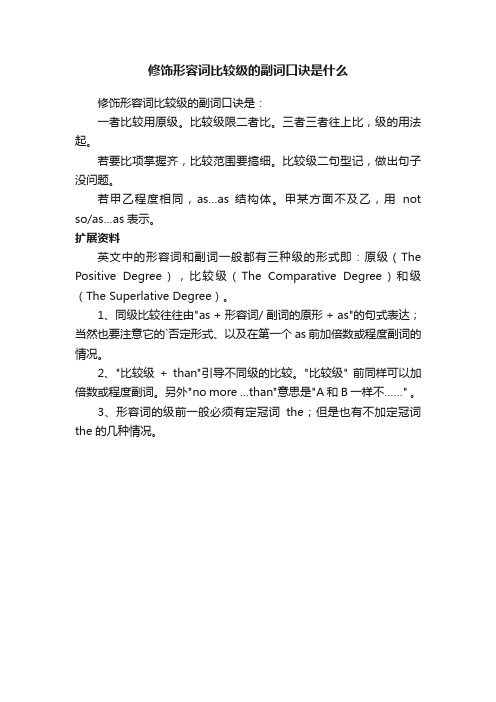
修饰形容词比较级的副词口诀是什么
修饰形容词比较级的副词口诀是:
一者比较用原级。
比较级限二者比。
三者三者往上比,级的用法起。
若要比项掌握齐,比较范围要搞细。
比较级二句型记,做出句子没问题。
若甲乙程度相同,as…as 结构体。
甲某方面不及乙,用not so/as…as表示。
扩展资料
英文中的形容词和副词一般都有三种级的形式即:原级(The Positive Degree),比较级(The Comparative Degree)和级(The Superlative Degree)。
1、同级比较往往由"as + 形容词/ 副词的原形 + as"的句式表达;当然也要注意它的`否定形式、以及在第一个as前加倍数或程度副词的情况。
2、"比较级+ than"引导不同级的比较。
"比较级" 前同样可以加倍数或程度副词。
另外"no more …than"意思是"A和B一样不……" 。
3、形容词的级前一般必须有定冠词the;但是也有不加定冠词the的几种情况。
形容词和副词的比较级口诀及用法总结

形容词和副词的比较级口诀及用法总结英语语法顺口溜:形容词和副词的比较级口诀一者比较用原级。
比较级限二者比。
三者三者往上比,最高级的用法起。
若要比项掌握齐,比较范围要搞细。
比较级二句型记,做出句子没问题。
若甲乙程度相同,as…as 结构体。
甲某方面不及乙,用not so/as…as表示。
上述内容全记起,比较等级谈完毕。
英文中的形容词和副词一般都有三种级的形式即:原级(The Positive Degree),比较级(The Comparative Degree)和最高级(The Superlative Degree)。
1) 同级比较往往由"as + 形容词/ 副词的原形 + as"的句式表达;当然也要注意它的否定形式、以及在第一个as前加倍数或程度副词的情况。
2)"比较级 + than"引导不同级的比较。
"比较级" 前同样可以加倍数或程度副词。
另外"no more …than"意思是"A和B一样不……" 。
3) 形容词的最高级前一般必须有定冠词the;但是也有不加定冠词the的几种情况。
一、同级比较中有两种情况:A 表示双方情况"一模一样",用as + 原级 + as的结构;B 表示双方情况"不(那么)一样",用not so / as + 原级 + as的结构。
在这两种结构中,第一个as是副词,而第二个as是连词;在第二个as的后面接名词、句子或代词的主格(一般不要接代词的宾格)。
例如:My parcel is as heavy as yours . 我的包裹与他的一样沉。
His bedroom is not as neat as his sister's. 他的卧室没有他姐姐的整洁。
It is not so hot as yesterday. 今天不象昨天那么热。
形容词比较级构成方法的记忆歌诀

二、形容词比拟级构成方法的记忆歌诀:两者之间作比拟,尾巴er少不了;一般词尾加er,有e词尾加r;单一辅音单音节,双写词尾加er辅音加y很重要,去y变i加er遇到双音和多音,最高级most放前最适宜。
三、形容词、副词比拟级和最高级局部用法歌诀:1.两者和三者、三者以上:两者比拟用than连接,三者比拟the在前;2.同级比拟歌诀:同级比拟用原级as…as…永不离,假设是否认加notas…as…否在前as…as…加not 只说两者有区别so…as…加not 后者总是强前者3.比拟级前常可放以下表修饰和程度的词:a little稍微, much得多, even更、还要,far得多, still要、还要, a lot, 得多rather相当。
四、形容词和副词比拟级、最高级的用法强调:定冠词在形容词最高级中使用但是在副词最高级中往往省略不用。
一. 写出以下各形容词的比拟级和最高级:1. nice _________2. fat _________3. slow _________4. dry _________5. happy _________6. wet _________7. much _________8. ill_________9. little _________ 10. bad _________11. thin _________12. far _________ 13. early _________ 14. careful________ 15. e*citing_______16.well______17.friendly________ 18. green_________ 19. few________ 20.busy_______二. 根据句意,用所括号所级形容词的比拟等级形式填空:1. mr. smith is _________ man in this office. (rich)2. winter is _________ season of the years. (cold)3. this radio is not so ________ as that one. (cheap)4. it is much _______ today than yesterday. (hot)5. she is a little ________ than her classmates. (careful)6. ________ people came to the meeting than last time. (many)7. which book is ________, this one or that one? (easy)8. my room is _______ than yours. (small)9. hainan is _______ from beijing than hunan. (far)10. skating is ___________ than swimming. (e*citing)11. jim is _______ than all the others. (honest)12. things are getting _______ and _______. (bad)13. the higher you climb, the _______ it will be. (cold)14. now our lives are being _________ and __________. (good)15. there are _______ boys than girls in our class. (few)16.the _______(hard) you work, the ________(happy) your parents will be.17.he is __________(tall) of the two.18.of all the subjects, he likes english _______(well).19.he runs __________(fast) of the three.20.he got _________(good) grades in his class.三、用适当形式填空:1. bob is _________ ( young ) than fred, but ___________ (tall) than fred.2. jim is not as ___________ (tall) as jack.3. almost all the students' faces are the samebut li deming looks _______ (fat) than before after the summer holidays.4.which is _________ (heavy), the hen or the chicken?5.-- how _________ (tall) is sally?-- she' s 1.55 metres ________ (tall). what about *iaoling?-- she' s only 1.40 metres ________ (tall).she is much _______ (short) than sally.she is also the _______ (short) girl in the class.6. he is ______ (bad) at learning maths. he is much _______ (bad) at chinese and he is the _________ (bad) at english.7. annie says sally is the ________ (kind) person in the world.8. he is one of the_________(friendly) people in the class, i think.9. a dictionary is much _________ (e*pensive) than a story-book.10. an orange is a little ______ (big) than an apple, but much ________ (small) than a watermelon.11. the changjiang river is the _______ (long) river in china.12. sue is a little ___________ (beautiful) than her sister.13. my room is not as _________ (big) as my brother' s.14.--how difficult is physics? --i' m not sure.-- is it ________ (difficult) than maths? -- I don’t think so.15.-- annie plays the piano very _________ (well).-- sue plays it _____ (well) than annie. and sally plays it the ______ (well).16. saturday is my _________ (busy) day in a week.17. her mother is getting ____________ (fat) and ________ (fat).18. i think it’s too e*pensive. i' d like a _____________ (cheap) one.19. he es to school much ____________ (early) than i.20. this book is not as _____________ (interesting) as that one.21. your classroom is __________ (wide) and ___________ (bright) than ours.22. practise as __________ (much) as you can.23. the ________ (much), the ____________ (good).24. nowadays(现在) english is __________( important )than any other subject, 1 think.25. most of the students think a lion is much ________ (dangerous) than a bear and it is the __________ (dangerous) animal in the world26. my brother is two years __________ (old) than me.27. tom is as ________(fat) as jim.28. is your sister __________(young) than you? yes,she is.29. who is ___________(thin),you or helen? helen is.30. whose pencil-bo* is __________(big),yours or hers? hers is.31. mary’s hair is as __________(long) as lucy’s.32.ben ______ (jump) ________ (high) than some of the boys in his class.33.________ nancy sing __________ (well) than helen? yes, she _____.34.fangfang is not as _________ (tall) as the other girls.35.my eyes are __________(big) than ________ (she)..36.which is ___________(heavy),the elephant or the pig?37.who gets up _________(early),tim or tom?38._____the girls get up_______(early) than the boys?no,they______.39. jim runs _____(slow). but ben runs _____(slow).40.the child doesn’t______(write) as ____(fast) as the students.41.he is as________(careful) as me, but mary doesn’t do her homework as______as me.四. 用of, than, in, as填空。
- 1、下载文档前请自行甄别文档内容的完整性,平台不提供额外的编辑、内容补充、找答案等附加服务。
- 2、"仅部分预览"的文档,不可在线预览部分如存在完整性等问题,可反馈申请退款(可完整预览的文档不适用该条件!)。
- 3、如文档侵犯您的权益,请联系客服反馈,我们会尽快为您处理(人工客服工作时间:9:00-18:30)。
小学英语形容词比较级顺口溜
比较级是形容词,一好一坏要记牢,
Good更好是better,
Bad更坏是worse
小学英语常见形容词及比较级变化一览表
1.在形容词词尾加上“er”“构成比较级:
cheap(便宜的)—cheaper clean(干净的)—cleaner clever(聪明的)—cleverer cold(寒冷的)—colder cool(凉的)—cooler fast(迅速的)—faster great(伟大的)—greater hard(困难的)—harder low(低的)—lower
high(高的)—higher kind(善良的)—kinder light(轻的)—lighter long(长的)—longer
near(近的)—nearer new(新的)—newer
quiet(安静的)—quieter short(短的)—shorter slow(慢的)—slower small(小的)—smaller smart(聪明的)—smarter strong(强壮的)—stronger sweet(甜的)—sweeter
tall(高的)——taller
young(年轻的)—younger
2.双写最后一个字母,再加上“er”构成比较级:
big(大的)—bigger fat(胖的)—fatter
hot(热的)—hotter sad(伤心的)—sadder thin(瘦的)—thinner
3.以不发音的字母e结尾的形容词,加上“r”构成比较级:
close(接近的)—closer fine(好的)—finer
large(巨大的)—larger late(迟的)—later
nice(好的)—nicer
white(白的)—whiter
3.以字母y结尾的形容词,把y改为i,再加上“er”构成比较级:
busy(忙碌的)—busier early(早的)—earlier easy(容易的)—easier friendly(友好的)—friendlier pretty(美丽的)—prettier funny(好玩的)—funnier happy(开心的)—happier healthy(健康的)—healthier heavy(重的)—heavier hungry(饿的)—hungrier lazy(懒惰的)—lazier lucky(幸运的)—luckier
4.noisy(嘈杂的)—noisier 不规则变化的形容词:
bad(坏的)—worse good(好的)—better far(远的)—farther ill(病的)—worse little(少的)—less
many(多的)—more much well(好的)—better
old(年老的)—older
5.在单词前面加上“more”构成比较级:
afraid(害怕的)—more afraid
beautiful(美丽的)—more beautiful
delicious(美味的)—more delicious
exciting(令人兴奋的)—more exciting
expensive(昂贵的)—more expensive
hard-working(勤奋的)—more hard-working
helpful(有帮助的)—more helpful
interesting(有趣的)—more interesting
polite(有礼貌的)—more polite
tired(累的)—more tired
询问某人的身高:
How tall +be动词+主语
例如:How tall is your brother?(你的弟弟有多高?)
He is 1.7 metres. (他有1.7米) 1.7(one point seven)询问某人的体重:
How heavy +be动词+主语
例如:How heavy is he?(你有多重?)
He is 49 kilograms.(他有49公斤)。
